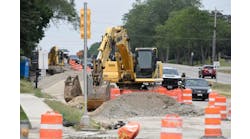Two-lift concrete paving just might be making a comeback in the U.S. Scarcity of aggregates, advances in materials knowledge and construction equipment and increasing demands for pavement surfaces that meet specific noise, durability and safety objectives are prompting the need to reconsider two-lift paving as a sustainable technique for building concrete pavements.
Two-lift construction involves the placement of two wet-on-wet layers instead of the homogenous single layer commonly placed in concrete paving. Two-lift paving can provide quality surface characteristics, reduce material costs and consume recycled aggregates (concrete and hot-mix asphalt).
Two-lift paving is not a new idea. The first concrete pavement constructed in the U.S., built in 1891 in Bellefontaine, Ohio, was a two-lift pavement. That pavement, designed to stand up to the wear and tear caused by horse-drawn wagons with steel wheels, is still in service today, as are other two-lift pavements built in the first decade of the 1900s in Michigan and Minnesota.
During the 1950s and 1960s, two-lift paving was implemented extensively in many states, including Iowa, Wisconsin, Michigan, Pennsylvania and Minnesota, to facilitate the placement of steel-reinforcing mesh in concrete interstate highway construction. Between 1970 and 2000, the U.S. concrete paving industry moved away from a jointed reinforced concrete pavement design and the use of mesh, significantly shortening the design length of pavement panels. The new design produced long-lasting pavements without steel reinforcement and eliminated the need for two-lift paving.
However, the high-quality, wear-resistant aggregates used to construct the U.S. pavements that have lasted 50-60 years are becoming scarce. As a result, two-lift paving is returning to the forefront as a sustainable, long-lasting pavement solution. Its potential benefits are attracting the attention of agencies and contractors across the country.
Working with the Union
Although two-lift paving fell out of use in the U.S., many European countries continued to use it and enjoy its benefits.
In May 2006, a team of 13 concrete pavement and materials specialists from the U.S. visited Canada and five countries in Europe to identify strategies and specifications used to design long-life concrete pavements. The team included members from the Federal Highway Administration (FHWA), state DOTs and the National Concrete Pavement Technology Center (National CP Tech Center), as well as contractors and materials suppliers.
After the scan tour, the team analyzed the techniques they had seen in Europe and selected two-lift paving as the strategy with the greatest potential for producing a cost-effective, sustainable, long-lasting pavement in the U.S.
Laying it on thick—and thin
Sustainable solutions are those that balance economic, environmental and social benefits.
“Sustainability is not about perfection,” said Tom Van Dam, program director for materials and sustainability at Applied Pavement Technology. “It’s about balancing competing, and often contradictory, interests.”
The two-lift process has great potential as a sustainable paving solution, said Van Dam. It reduces the cost of materials and materials transportation, reduces the environmental impact caused by quarrying and importing aggregates and increases societal benefits by lowering noise levels and providing a long-lasting pavement that does not need frequent reconstruction.
In two-lift paving, the bottom layer is thick, typically 80-90% of the total pavement thickness. The bottom lift generally contains locally available or recycled aggregates that may not be suitable as a wearing surface. These aggregates can be obtained at a lower cost than aggregates used in a traditional paving project.
The top layer, on the other hand, is relatively thin and contains dense, wear-resistant aggregates that provide enhanced durability, reduced noise and increased friction. While these aggregates are more costly and frequently have to be imported, the overall cost and environmental impact of the pavement system is reduced because only a small amount of aggregates is required.
“Two-lift is optimized for recycling and reuse,” said Joep Meijer, president of the Right Environment, an environmental consulting firm in Austin, Texas. “Recycling is basically embedded in the technology.”
Since the bottom lift is not subjected to as harsh an environment as the top lift, a variety of recycled aggregates, including concrete or asphalt pavements, can be used in the bottom lift without sacrificing durability.
“We can use the road that is already there—just crush it up and use it in the new road,” explained Meijer.
Two-lift paving also can be optimized to reduce the environmental impact caused by cement production.
“The concrete industry is well aware of the energy intensity and CO2 emissions related to cement production, so we’re looking into options to reduce clinker content from cement,” said Meijer.
One way to reduce the cement content of concrete is to use supplementary cementitious materials, such as fly ash. This strategy is commonly used in concrete paving projects and can be used in higher quantities in two-lift paving.
Quiet, safe, long-lasting pavements mean happy citizens. Two-lift pavements have the potential to meet all of these criteria through surface treatments such as exposed aggregate surfaces.
Creating an exposed aggregate surface requires using extra-hard, wear-resistant, small aggregates. When small aggregates are used, more cement paste must be used, which increases both the cost of the concrete mix and the energy and CO2 footprint of the pavement. However, the thin top lift of a two-lift pavement needs only a relatively small amount of concrete, making exposed aggregate surfaces a possibility without increasing the cost or the environmental impact.
Results from Europe, where exposed aggregate surfaces are commonly used, suggest that these surfaces reduce tire-pavement noise, leading to quieter pavements. The team also hopes that exposed aggregate surfaces will increase skid resistance, potentially making the pavement safer.
American-made case
Once the European scan team identified two-lift paving as its first priority, the next step was to set up demonstration projects in various locations throughout the U.S. Working with the FHWA, the National CP Tech Center coordinated the first demonstration project in Kansas.
“In Kansas, they were struggling because the local limestone in Kansas is not wear-resistant,” explained Van Dam. Kansas would like to import aggregates that are denser and more wear-resistant from other states, but these imported aggregates come at a higher cost.
While reducing costs is a plus, it was not the primary reason Kansas volunteered to do a demonstration project, said Rod Montney, a concrete research engineer with the Kansas DOT.
“Our goal was really just to prove that two-lift paving could be done in the U.S. with American equipment,” he said.
For the I-70 two-lift project, Kansas imported dense, wear-resistant rhyolite aggregates from Oklahoma for the top lift but used locally available, more porous limestone aggregates for the bottom lift, significantly lowering the cost of purchasing and transporting materials.
The team used a standard Kansas DOT paving mix for the 300-mm bottom lift. They also used a combination of admixtures to stiffen the bottom lift and prevent segregation.
The rhyolite was used as a coarse aggregate in the 40-mm top lift. To reduce permeability, the contractor substituted a Class F fly ash-gypsum combination for 20% of the cement in the top lift.
The Kansas DOT contracted with Koss Construction for the I-70 two-lift project.
“Koss got on board right from the beginning,” said Montney. “They had been thinking about two-lift paving and said, ‘Let’s try it on the I-70 project.’”
Koss used a dual-drum mixing plant to simultaneously produce the two concrete mixes. Green and red placards were used to identify which mix each truck was carrying: a green placard told the road crew the truck was delivering to the bottom lift spreader (which was marked with green paint); a red placard indicated the concrete was for the top lift spreader (which was marked with red paint).
The pavement was placed on a 150-mm, cement-treated recycled concrete base produced from the pre-existing concrete pavement.
During the paving process, the bottom-lift concrete was placed in the belt spreader to deliver concrete to the base. The first paver followed behind the belt spreader to form the final pavement profile for the bottom lift. Almost immediately after the bottom lift was placed, it was stiff enough to support the weight of the workers.
The top lift was then delivered to a second belt spreader, with the second paver forming the final pavement profile. The total distance of the paving operation from the first belt spreader to the final paver was less than 45 meters. In this wet-on-wet application, both the bottom and top lifts were completed in about 30-60 minutes.
The Kansas DOT experimented with several different pavement surface textures as part of the I-70 two-lift project, including longitudinal tining, grooving, Astroturf drag and an exposed aggregate surface.
The exposed aggregate surface contained a much smaller aggregate—9.5-mm rhyolite—compared with the other surface test sections, which used 12.5-mm rhyolite in the top lift. Fine mason sand was used in the exposed aggregate section, whereas standard river sand was used in other top-lift surface test sections.
To create the exposed aggregate surface, retarder was sprayed on the surface of the top lift to prevent the concrete from setting. White sheeting was used to cure the retarded surface.
After a five-hour curing time, the white sheeting was removed and the surface exposed for 15-20 minutes before brooming to remove the retarded paste from the surface and expose the aggregate. After brooming, white curing compound was applied to provide final cure for the exposed aggregate surface. Transverse and longitudinal joints were later sawed into the surface.
On-board sound intensity (OBSI) tests were conducted on each of the different surface textures. All surfaces showed lower tire-pavement noise than a traditional concrete pavement.
Opening minds
Nearly 100 people—contractors, material suppliers and agency representatives—from 15 states attended the National Two-Lift Paving Open House in Salina, Kan., on Oct. 15-16, 2008.
Participants heard presentations from European and U.S. experts, including those involved with the Kansas project. They also visited the project site and examined the exposed aggregate and other experimental surfaces.
Additional open houses will be held as other demonstration projects are completed over the next two years.
The National CP Tech Center is setting up demonstration projects in other states in 2009. The goal is to have two more open houses in the next year or two, said director Tom Cackler.
Cackler sees two-lift paving as a tool that can help “optimize concrete pavements to meet local needs—such as specific surface characteristics, scarcity of local materials or recycling of existing pavements—so that a long-life pavement can be built with an economic and sustainable approach.”
Van Dam said he expects to see a lot more versatility with two-lift paving in the future.
“Once we’ve proved the concept, people will start to think about optimizing the top layer to resist moisture loss, resist cracking . . . There are a lot of potential benefits we haven’t even begun to realize,” he said.
The ill effects of moisture loss can be reduced through the use of internal curing or shrinkage-reducing admixtures, explained Van Dam, and fiber reinforcement can be used to help reduce cracking.
“When it comes to two-lift paving,” he said, “we’re just scratching the surface.”
For more information about two-lift paving and the Kansas demonstration project, visit the National CP Tech Center’s website at www.cptechcenter.org/projects/two-liftpaving/index.cfm.


